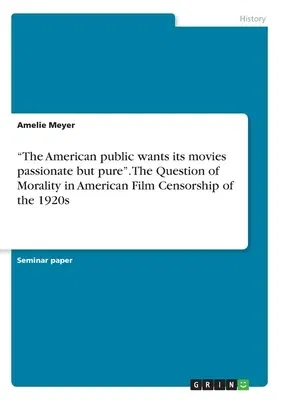Seminar paper from the year 2012 in the subject History - America,
grade: 1,0, University of Göttingen (Seminar für Mittlere und Neuere
Geschichte), course: The "Roaring Twenties" Die Massenkultur der 1920er
Jahre in transatlantischer Perspektive, language: English, abstract: For
as long as there have been moving pictures, there have also been
attempts to regulate their content. The first court case surrounding
moving pictures has been recorded as early as 1897 and many more were to
follow. While film was thus always subjected to scrutiny from various
groups, the 1920s saw a more fervent battle for control over censorship
which resulted in the formation of the 1930 Production Code remaining in
effect until 1968. Lee Grieveson's study Policing Cinema: Movies and
Censorship in Early-Twentieth-Century America comprehensively describes
long-lasting battles over movie content regulation and the discussion of
the function of cinema. Yet, he is among many scholars who sees the 1915
Supreme Court decision in the case "Mutual Film Corporation v.
Industrial Commission of Ohio" as the culmination of these struggles as
it proved "the validity of state censorship." Justice McKenna is quoted
ruling that "the exhibition of moving picture is a business, pure and
simple, originated and conducted for profit, like other spectacles, not
to be regarded ... as part of the press of the country, or as organs of
the public opinion." This ruling was not only significant for the
increased state and city censorship which followed, but it also fueled
censorship demands by various parties including religious groups, social
reformers, politicians, and journalists who all called for the elusive
concept of morality. The road from this first ruling which titled the
film industry as a business to be regulated towards a formal censorship
with the aim of restoring morality manifested in the so-called
Production Code in 1934 will be the focus of this paper. The first part
will consist of an analysi


